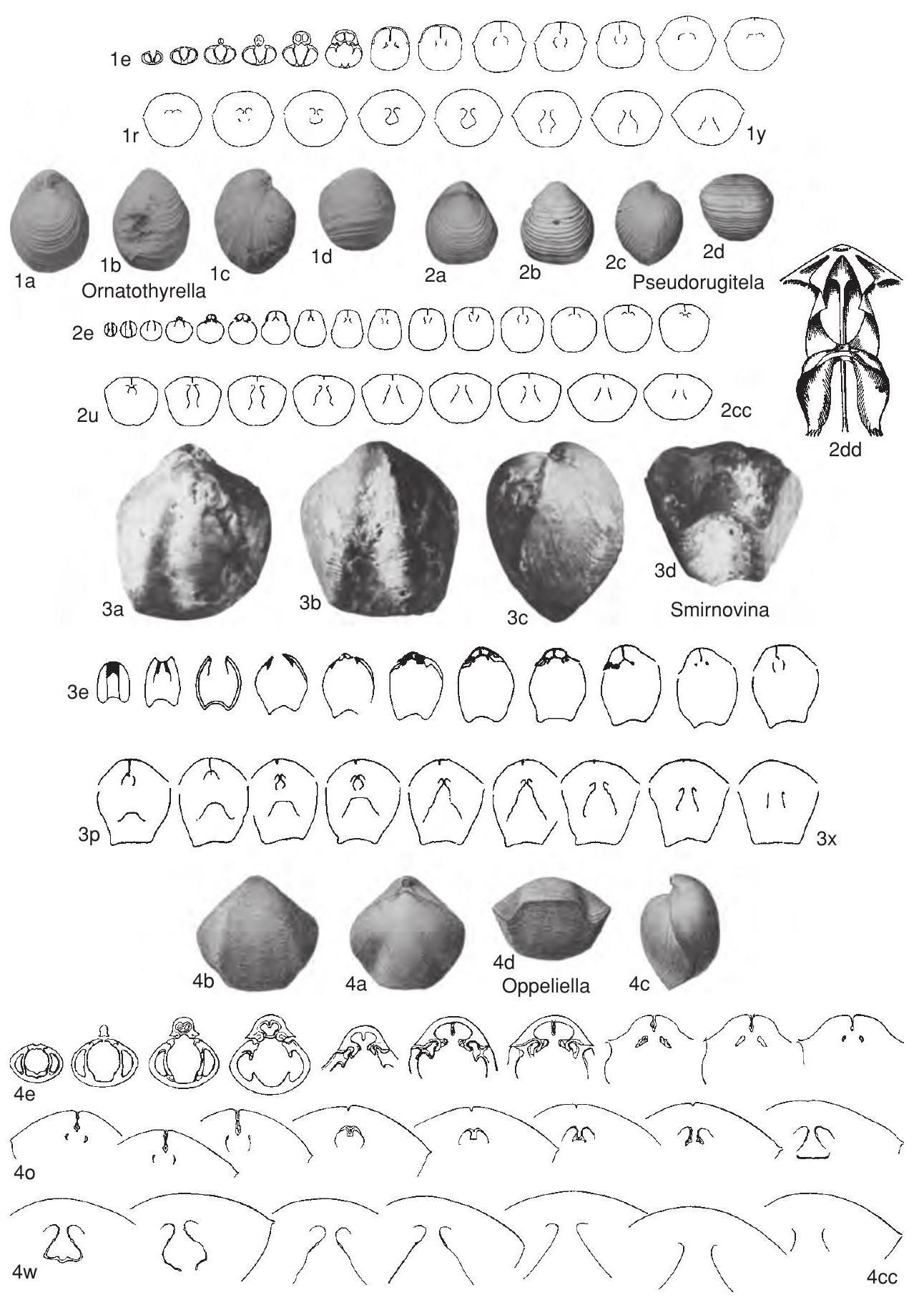Welcome to the Treatise on Invertebrate Paleontology!
Please enter a genera name to retrieve more information.

Pseudorugitela
Classification
Phylum:
Brachiopoda
Subphylum:
Rhynchonelliformea
Class:
Rhynchonellata
Order:
Terebratulida
Suborder:
Terebratellidina
Superfamily:
Kingenoidea
Family:
Aulacothyropsidae
Subfamily:
Aulacothyropsinae
Formal Genus Name and Reference:
Pseudorugitela DAGYS, 1959b, p. 100
Type Species:
Waldheimia (Aulacothyris) pulchella BITTNER, 1890, p. 200, OD
Images
(Click to enlarge in a new window)
Fig. 1459, 2a-dd. *P. pulchella (Bittner), Norian, Kuma River, northwestern Caucasus, a-d, dorsal, ventral, lateral, and anterior views, × 2 (Dagys, 1963), e-cc, serial transverse sections 0.0, 0.3, 0.6, 0.9, 1.3, 1.6, 1.8, 2.1, 2.3, 2.6, 3.0, 3.2, 3.5, 3.9, 4.2, 4.4, 5.0, 5.5, 5.7, 6.1, 6.5, 7.6, 8.9, 9.4, 10.3 mm from first section, × 2 (adapted from Dagys, 1959b), dd, loop reconstruction, × 4 (Dagys, 1974).
Synonyms
Geographic Distribution
Alps, Carpathians, northwestern Caucasus, Pamirs, China
Age Range
Beginning Stage in Treatise Usage:
Upper Triassic (Carnian)
Beginning International Stage:
Carnian
Fraction Up In Beginning Stage:
0
Beginning Date:
237
Ending Stage in Treatise Usage:
Upper Triassic (Norian)
Ending International Stage:
Norian
Fraction Up In Ending Stage:
100
Ending Date:
205.74
Description
Small, biconvex, rounded subpentagonal in outline, surface ornament of concentric rugae, anterior commissure rectimarginate, tending to anterior ligation, umbo short, erect, beak ridges distinct, foramen minute, mesothyrid, dental plates thin, parallel, and united to pedicle collar, dorsal septalium Y-shaped, loop similar to that of Aulacothyropsis but spinose only anteriorly
References
Museum or Author Information
Classification
Phylum:
Brachiopoda
Subphylum:
Rhynchonelliformea
Class:
Rhynchonellata
Order:
Terebratulida
Suborder:
Terebratellidina
Superfamily:
Kingenoidea
Family:
Aulacothyropsidae
Subfamily:
Aulacothyropsinae
Formal Genus Name and Reference:
Pseudorugitela DAGYS, 1959b, p. 100
Type Species:
Waldheimia (Aulacothyris) pulchella BITTNER, 1890, p. 200, OD
Images
(Click to enlarge in a new window)
Fig. 1459, 2a-dd. *P. pulchella (Bittner), Norian, Kuma River, northwestern Caucasus, a-d, dorsal, ventral, lateral, and anterior views, × 2 (Dagys, 1963), e-cc, serial transverse sections 0.0, 0.3, 0.6, 0.9, 1.3, 1.6, 1.8, 2.1, 2.3, 2.6, 3.0, 3.2, 3.5, 3.9, 4.2, 4.4, 5.0, 5.5, 5.7, 6.1, 6.5, 7.6, 8.9, 9.4, 10.3 mm from first section, × 2 (adapted from Dagys, 1959b), dd, loop reconstruction, × 4 (Dagys, 1974).
Synonyms
Geographic Distribution
Alps, Carpathians, northwestern Caucasus, Pamirs, China
Age Range
Beginning Stage in Treatise Usage:
Upper Triassic (Carnian)
Beginning International Stage:
Carnian
Fraction Up In Beginning Stage:
0
Beginning Date:
237
Ending Stage in Treatise Usage:
Upper Triassic (Norian)
Ending International Stage:
Norian
Fraction Up In Ending Stage:
100
Ending Date:
205.74
Description
Small, biconvex, rounded subpentagonal in outline, surface ornament of concentric rugae, anterior commissure rectimarginate, tending to anterior ligation, umbo short, erect, beak ridges distinct, foramen minute, mesothyrid, dental plates thin, parallel, and united to pedicle collar, dorsal septalium Y-shaped, loop similar to that of Aulacothyropsis but spinose only anteriorly
